Economic Principles: Time Perspective Principle Analysis
VerifiedAdded on 2022/08/14
|7
|1329
|32
Essay
AI Summary
This essay delves into the time perspective principle in economics, emphasizing the importance of considering both short-run and long-run effects in business decision-making. It defines the principle as the need for businesses to analyze revenue structures and costing aspects across different time periods to maximize profit and growth. The essay differentiates between short-run decisions, where some factors are fixed, and long-run decisions, where all factors are variable. It highlights that while short-term approaches may offer limited production capacity, long-term strategies enable businesses to adapt and potentially increase revenue. The essay also notes that while long-term approaches involve greater risk due to variable factors, the potential for profit often outweighs the initial costs. The conclusion summarizes the time perspective principle as an investment strategy that involves long-term commitment, adaptability, and consideration of various market variables.
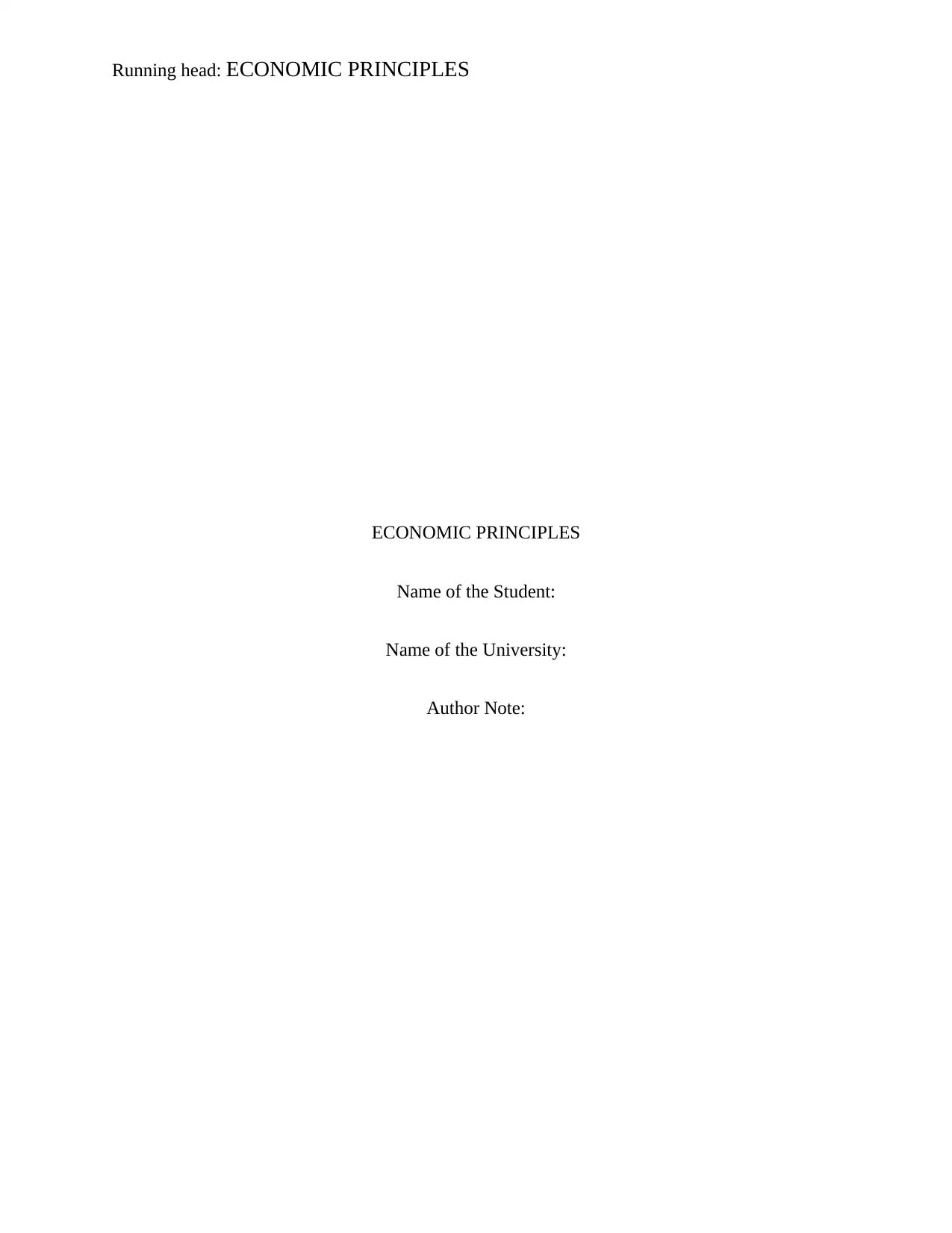
Running head: ECONOMIC PRINCIPLES
ECONOMIC PRINCIPLES
Name of the Student:
Name of the University:
Author Note:
ECONOMIC PRINCIPLES
Name of the Student:
Name of the University:
Author Note:
Paraphrase This Document
Need a fresh take? Get an instant paraphrase of this document with our AI Paraphraser
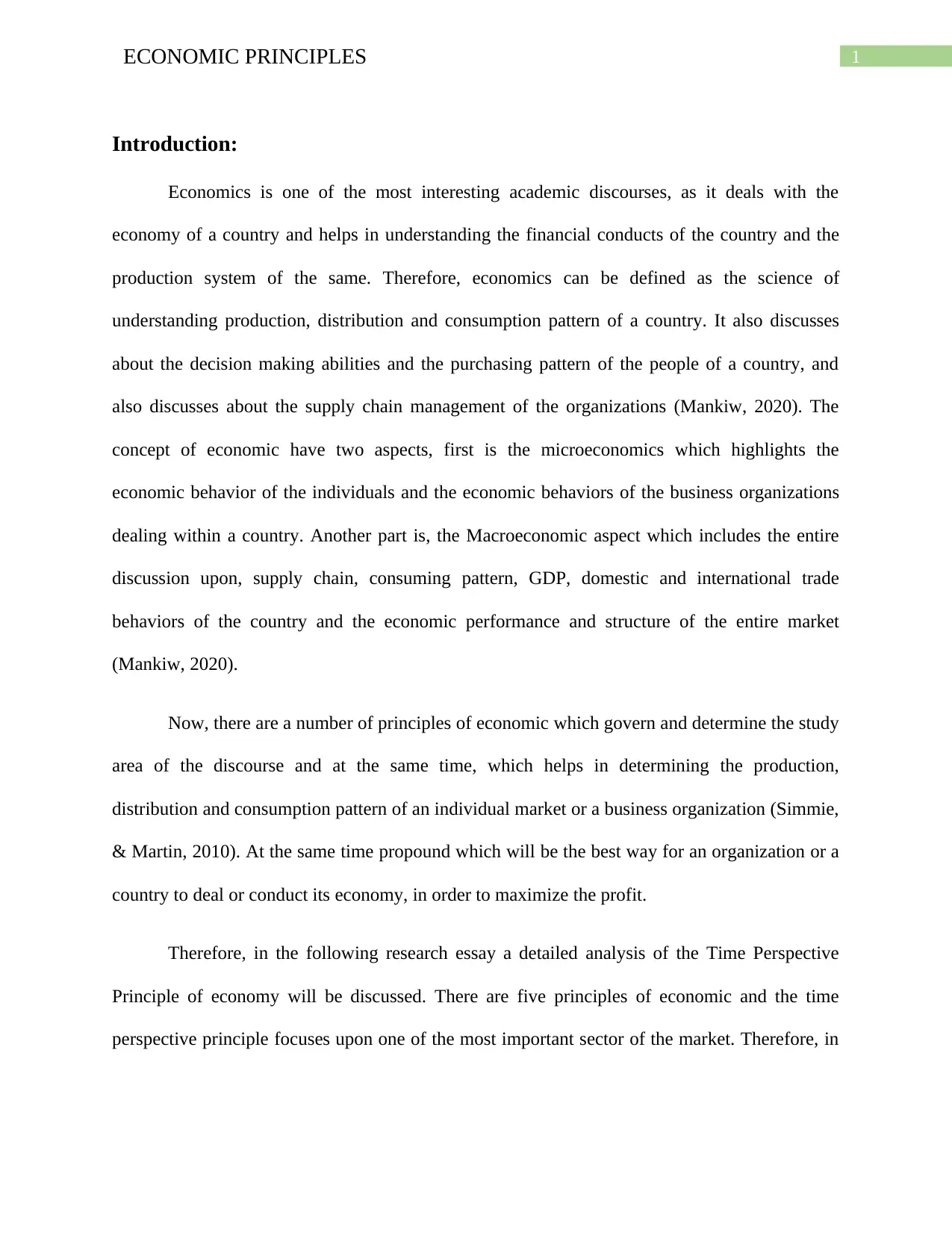
1ECONOMIC PRINCIPLES
Introduction:
Economics is one of the most interesting academic discourses, as it deals with the
economy of a country and helps in understanding the financial conducts of the country and the
production system of the same. Therefore, economics can be defined as the science of
understanding production, distribution and consumption pattern of a country. It also discusses
about the decision making abilities and the purchasing pattern of the people of a country, and
also discusses about the supply chain management of the organizations (Mankiw, 2020). The
concept of economic have two aspects, first is the microeconomics which highlights the
economic behavior of the individuals and the economic behaviors of the business organizations
dealing within a country. Another part is, the Macroeconomic aspect which includes the entire
discussion upon, supply chain, consuming pattern, GDP, domestic and international trade
behaviors of the country and the economic performance and structure of the entire market
(Mankiw, 2020).
Now, there are a number of principles of economic which govern and determine the study
area of the discourse and at the same time, which helps in determining the production,
distribution and consumption pattern of an individual market or a business organization (Simmie,
& Martin, 2010). At the same time propound which will be the best way for an organization or a
country to deal or conduct its economy, in order to maximize the profit.
Therefore, in the following research essay a detailed analysis of the Time Perspective
Principle of economy will be discussed. There are five principles of economic and the time
perspective principle focuses upon one of the most important sector of the market. Therefore, in
Introduction:
Economics is one of the most interesting academic discourses, as it deals with the
economy of a country and helps in understanding the financial conducts of the country and the
production system of the same. Therefore, economics can be defined as the science of
understanding production, distribution and consumption pattern of a country. It also discusses
about the decision making abilities and the purchasing pattern of the people of a country, and
also discusses about the supply chain management of the organizations (Mankiw, 2020). The
concept of economic have two aspects, first is the microeconomics which highlights the
economic behavior of the individuals and the economic behaviors of the business organizations
dealing within a country. Another part is, the Macroeconomic aspect which includes the entire
discussion upon, supply chain, consuming pattern, GDP, domestic and international trade
behaviors of the country and the economic performance and structure of the entire market
(Mankiw, 2020).
Now, there are a number of principles of economic which govern and determine the study
area of the discourse and at the same time, which helps in determining the production,
distribution and consumption pattern of an individual market or a business organization (Simmie,
& Martin, 2010). At the same time propound which will be the best way for an organization or a
country to deal or conduct its economy, in order to maximize the profit.
Therefore, in the following research essay a detailed analysis of the Time Perspective
Principle of economy will be discussed. There are five principles of economic and the time
perspective principle focuses upon one of the most important sector of the market. Therefore, in
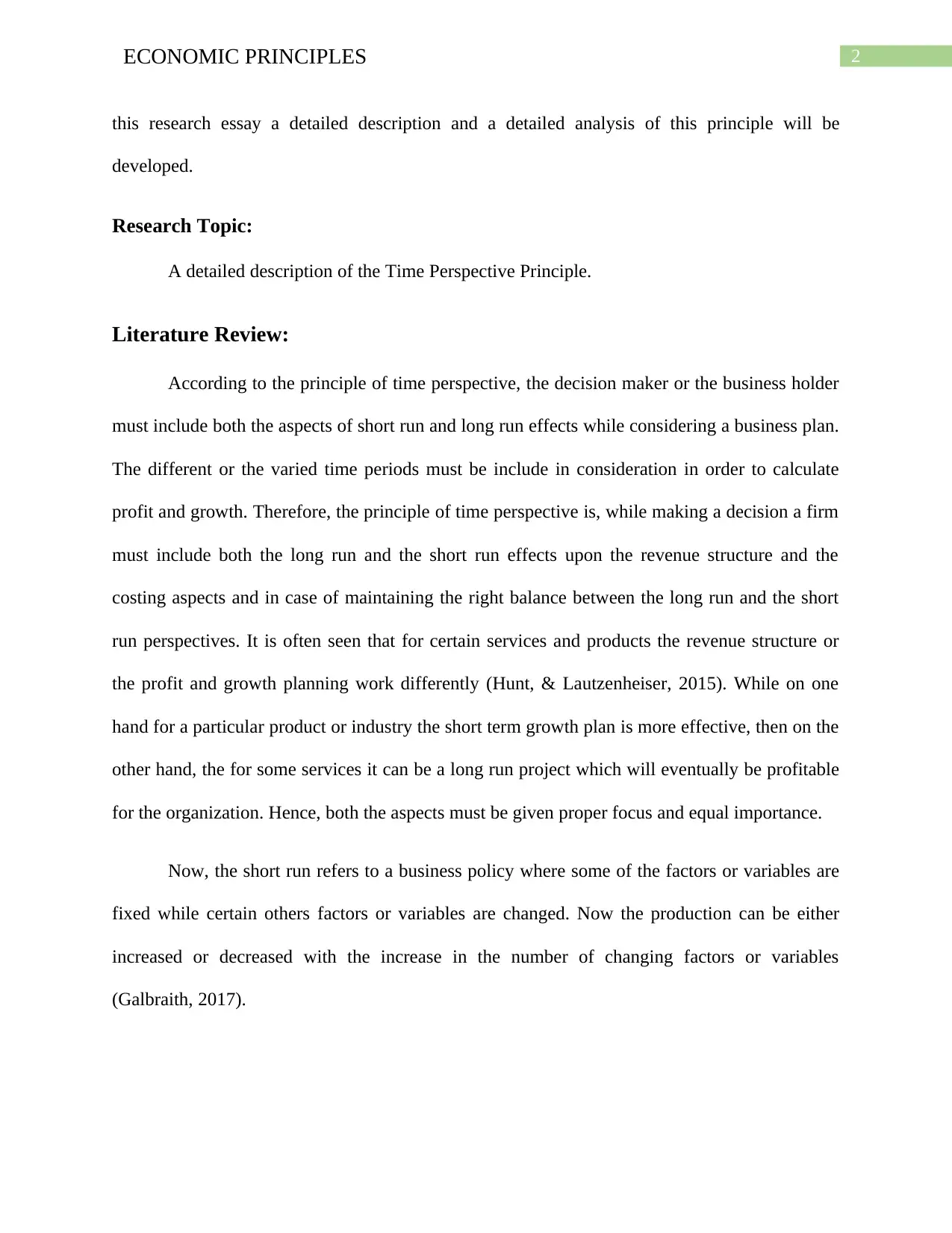
2ECONOMIC PRINCIPLES
this research essay a detailed description and a detailed analysis of this principle will be
developed.
Research Topic:
A detailed description of the Time Perspective Principle.
Literature Review:
According to the principle of time perspective, the decision maker or the business holder
must include both the aspects of short run and long run effects while considering a business plan.
The different or the varied time periods must be include in consideration in order to calculate
profit and growth. Therefore, the principle of time perspective is, while making a decision a firm
must include both the long run and the short run effects upon the revenue structure and the
costing aspects and in case of maintaining the right balance between the long run and the short
run perspectives. It is often seen that for certain services and products the revenue structure or
the profit and growth planning work differently (Hunt, & Lautzenheiser, 2015). While on one
hand for a particular product or industry the short term growth plan is more effective, then on the
other hand, the for some services it can be a long run project which will eventually be profitable
for the organization. Hence, both the aspects must be given proper focus and equal importance.
Now, the short run refers to a business policy where some of the factors or variables are
fixed while certain others factors or variables are changed. Now the production can be either
increased or decreased with the increase in the number of changing factors or variables
(Galbraith, 2017).
this research essay a detailed description and a detailed analysis of this principle will be
developed.
Research Topic:
A detailed description of the Time Perspective Principle.
Literature Review:
According to the principle of time perspective, the decision maker or the business holder
must include both the aspects of short run and long run effects while considering a business plan.
The different or the varied time periods must be include in consideration in order to calculate
profit and growth. Therefore, the principle of time perspective is, while making a decision a firm
must include both the long run and the short run effects upon the revenue structure and the
costing aspects and in case of maintaining the right balance between the long run and the short
run perspectives. It is often seen that for certain services and products the revenue structure or
the profit and growth planning work differently (Hunt, & Lautzenheiser, 2015). While on one
hand for a particular product or industry the short term growth plan is more effective, then on the
other hand, the for some services it can be a long run project which will eventually be profitable
for the organization. Hence, both the aspects must be given proper focus and equal importance.
Now, the short run refers to a business policy where some of the factors or variables are
fixed while certain others factors or variables are changed. Now the production can be either
increased or decreased with the increase in the number of changing factors or variables
(Galbraith, 2017).
⊘ This is a preview!⊘
Do you want full access?
Subscribe today to unlock all pages.

Trusted by 1+ million students worldwide

3ECONOMIC PRINCIPLES
The long run business decision, on the other hand is the business decision where all the
factors are variables, none of them have any fixed values, therefore making the profit or the
revenue generation delayed.
However, as according to the researchers and the economists, practically the difference or
the distinction between these two aspects is very limited, and in certain cases the lines get
blurred, and only the estimated cost of the products and services vary. Therefore, according to
the economists it is the decision making ability if the business men or the investors, which is
important considering a particular business proposal. It is the managerial decision to balance
between the business decisions, and it is only guided by the revenue structure and the costing of
the business (Mankiw, 2020). Moreover, in certain areas these two aspects can overleap with
each other, for example, certain business can be based upon short term considerations while
having long term impacts, or may result in either gaining more or less profit than had been
expected.
According to some of the business owners, it is better and effective to deal in the long
term period. If a firm considers a long term approach, then it can easily shift the size of the
business as per requirement and therefore, it can change its output along with the changing size
(Mankiw, 2016). However, in case of the short term approach, the output of the industry is fixed
therefore, the size of the business or the industry cannot be changed. Therefore, the profit or the
revenue structure of the business in case of a business with a short term approach is limited along
with its ability of production, while on the other hand, the in case of a business house with a long
term approach is more likely to be able to increase its profit or revenue structure (Kalecki,,
2013). As the long term approach includes a variety of variables each changing, therefore, the
output of the industry is also like to increase, thus changing its size.
The long run business decision, on the other hand is the business decision where all the
factors are variables, none of them have any fixed values, therefore making the profit or the
revenue generation delayed.
However, as according to the researchers and the economists, practically the difference or
the distinction between these two aspects is very limited, and in certain cases the lines get
blurred, and only the estimated cost of the products and services vary. Therefore, according to
the economists it is the decision making ability if the business men or the investors, which is
important considering a particular business proposal. It is the managerial decision to balance
between the business decisions, and it is only guided by the revenue structure and the costing of
the business (Mankiw, 2020). Moreover, in certain areas these two aspects can overleap with
each other, for example, certain business can be based upon short term considerations while
having long term impacts, or may result in either gaining more or less profit than had been
expected.
According to some of the business owners, it is better and effective to deal in the long
term period. If a firm considers a long term approach, then it can easily shift the size of the
business as per requirement and therefore, it can change its output along with the changing size
(Mankiw, 2016). However, in case of the short term approach, the output of the industry is fixed
therefore, the size of the business or the industry cannot be changed. Therefore, the profit or the
revenue structure of the business in case of a business with a short term approach is limited along
with its ability of production, while on the other hand, the in case of a business house with a long
term approach is more likely to be able to increase its profit or revenue structure (Kalecki,,
2013). As the long term approach includes a variety of variables each changing, therefore, the
output of the industry is also like to increase, thus changing its size.
Paraphrase This Document
Need a fresh take? Get an instant paraphrase of this document with our AI Paraphraser
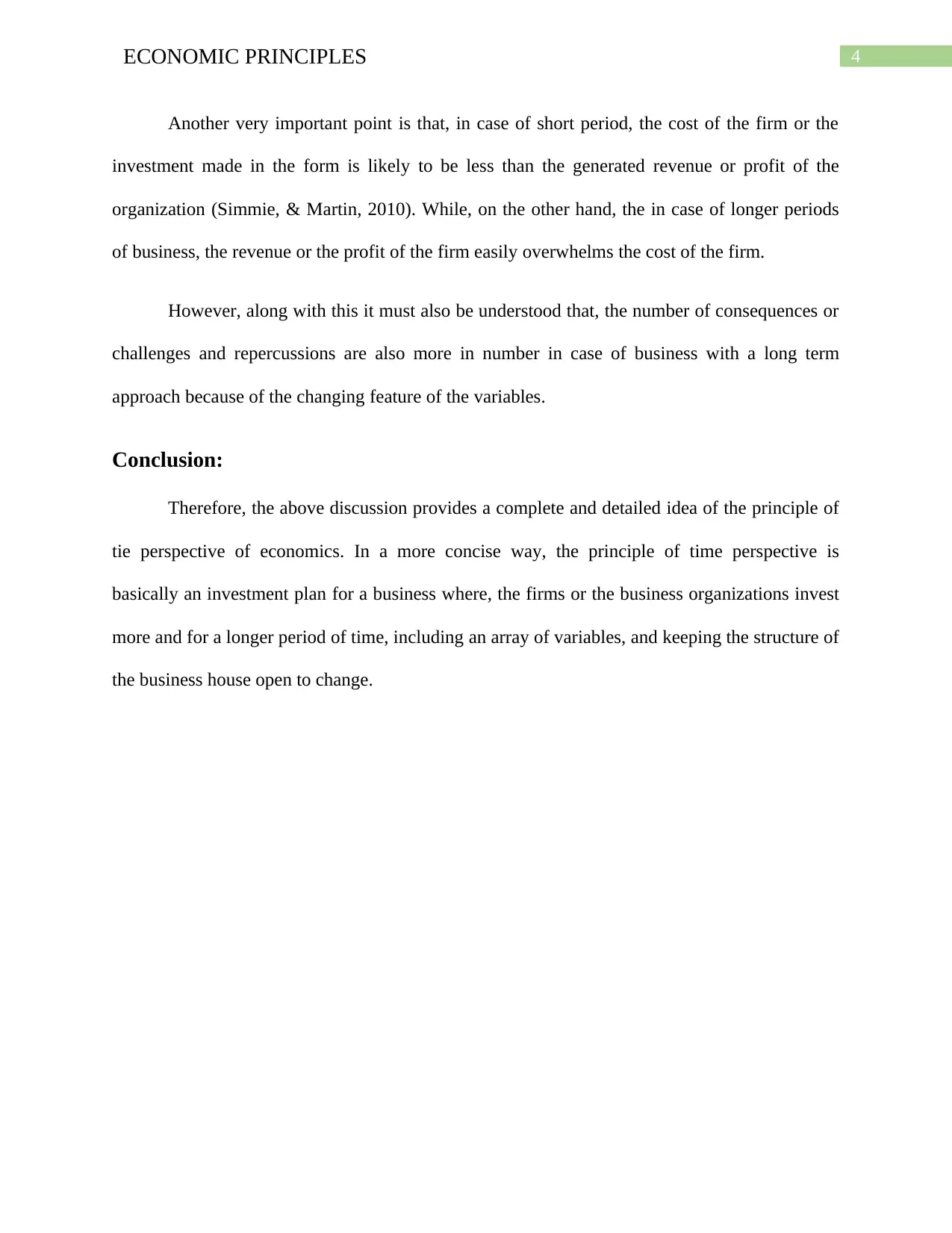
4ECONOMIC PRINCIPLES
Another very important point is that, in case of short period, the cost of the firm or the
investment made in the form is likely to be less than the generated revenue or profit of the
organization (Simmie, & Martin, 2010). While, on the other hand, the in case of longer periods
of business, the revenue or the profit of the firm easily overwhelms the cost of the firm.
However, along with this it must also be understood that, the number of consequences or
challenges and repercussions are also more in number in case of business with a long term
approach because of the changing feature of the variables.
Conclusion:
Therefore, the above discussion provides a complete and detailed idea of the principle of
tie perspective of economics. In a more concise way, the principle of time perspective is
basically an investment plan for a business where, the firms or the business organizations invest
more and for a longer period of time, including an array of variables, and keeping the structure of
the business house open to change.
Another very important point is that, in case of short period, the cost of the firm or the
investment made in the form is likely to be less than the generated revenue or profit of the
organization (Simmie, & Martin, 2010). While, on the other hand, the in case of longer periods
of business, the revenue or the profit of the firm easily overwhelms the cost of the firm.
However, along with this it must also be understood that, the number of consequences or
challenges and repercussions are also more in number in case of business with a long term
approach because of the changing feature of the variables.
Conclusion:
Therefore, the above discussion provides a complete and detailed idea of the principle of
tie perspective of economics. In a more concise way, the principle of time perspective is
basically an investment plan for a business where, the firms or the business organizations invest
more and for a longer period of time, including an array of variables, and keeping the structure of
the business house open to change.
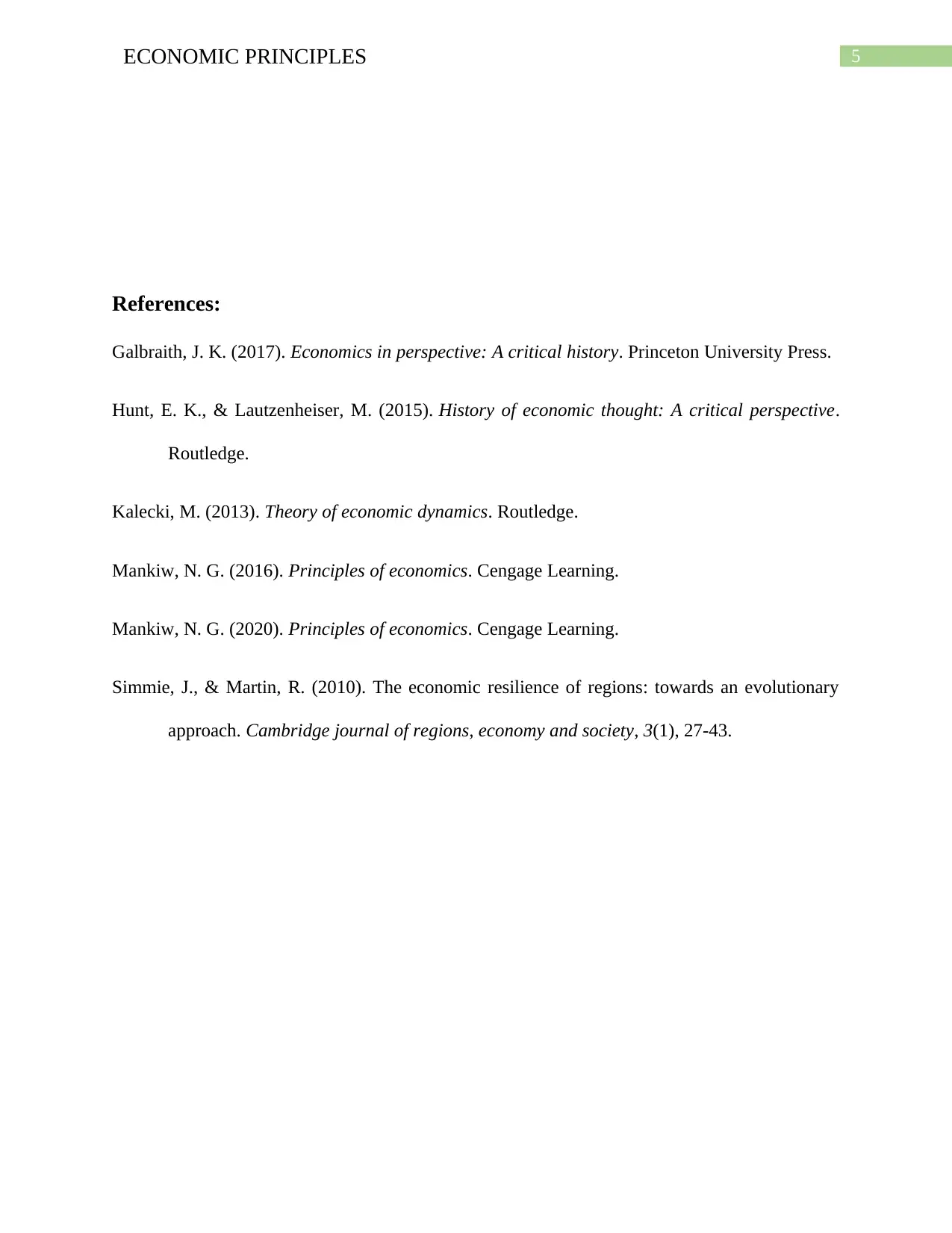
5ECONOMIC PRINCIPLES
References:
Galbraith, J. K. (2017). Economics in perspective: A critical history. Princeton University Press.
Hunt, E. K., & Lautzenheiser, M. (2015). History of economic thought: A critical perspective.
Routledge.
Kalecki, M. (2013). Theory of economic dynamics. Routledge.
Mankiw, N. G. (2016). Principles of economics. Cengage Learning.
Mankiw, N. G. (2020). Principles of economics. Cengage Learning.
Simmie, J., & Martin, R. (2010). The economic resilience of regions: towards an evolutionary
approach. Cambridge journal of regions, economy and society, 3(1), 27-43.
References:
Galbraith, J. K. (2017). Economics in perspective: A critical history. Princeton University Press.
Hunt, E. K., & Lautzenheiser, M. (2015). History of economic thought: A critical perspective.
Routledge.
Kalecki, M. (2013). Theory of economic dynamics. Routledge.
Mankiw, N. G. (2016). Principles of economics. Cengage Learning.
Mankiw, N. G. (2020). Principles of economics. Cengage Learning.
Simmie, J., & Martin, R. (2010). The economic resilience of regions: towards an evolutionary
approach. Cambridge journal of regions, economy and society, 3(1), 27-43.
⊘ This is a preview!⊘
Do you want full access?
Subscribe today to unlock all pages.

Trusted by 1+ million students worldwide
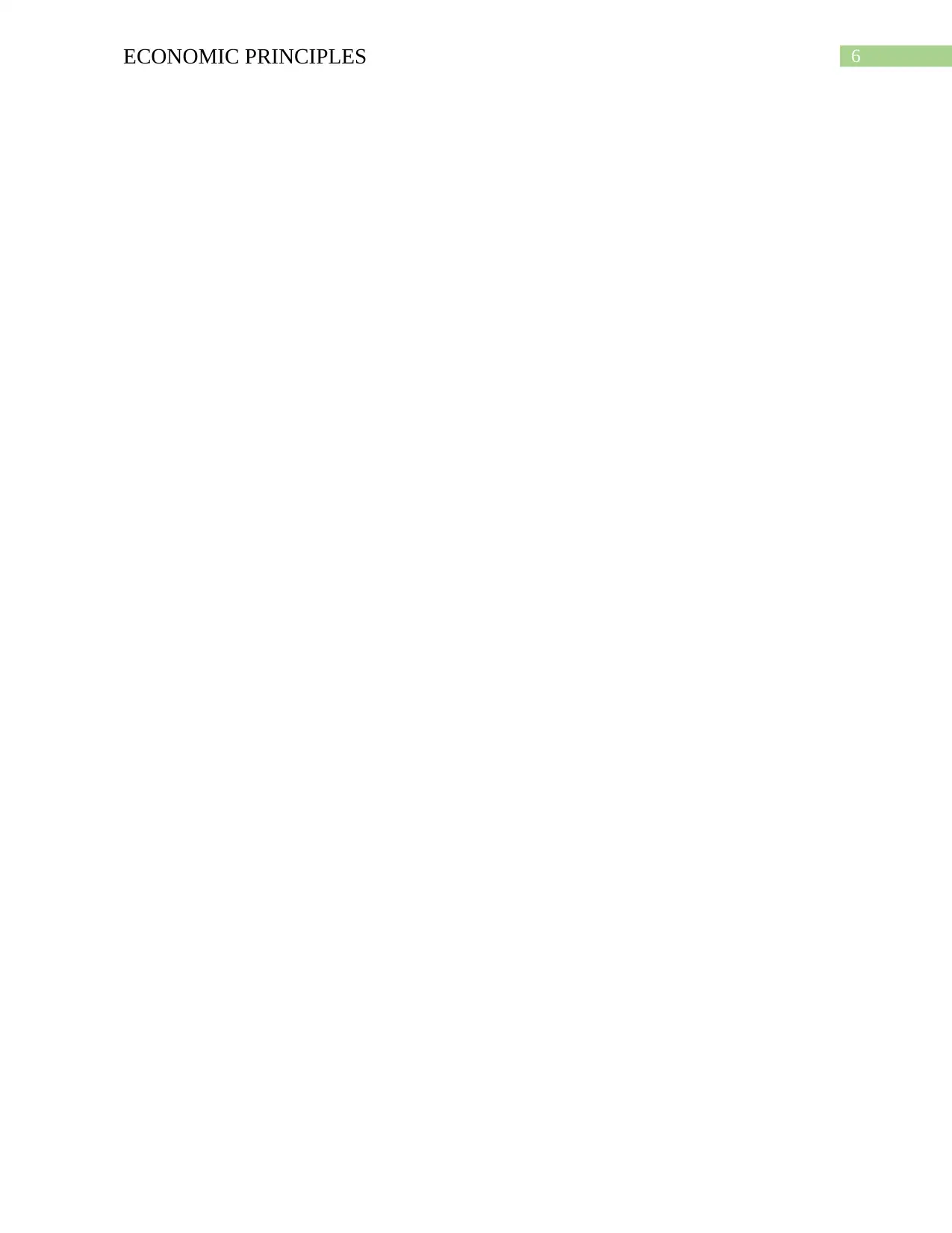
6ECONOMIC PRINCIPLES
1 out of 7
Related Documents
Your All-in-One AI-Powered Toolkit for Academic Success.
+13062052269
info@desklib.com
Available 24*7 on WhatsApp / Email
![[object Object]](/_next/static/media/star-bottom.7253800d.svg)
Unlock your academic potential
Copyright © 2020–2025 A2Z Services. All Rights Reserved. Developed and managed by ZUCOL.




